Rolandius@legacy41568095 (talk | contribs) m (Corrected spelling/grammar) |
Rolandius@legacy41568095 (talk | contribs) m (Cleanup; Corrected spelling/grammar) |
||
| Line 18: | Line 18: | ||
== Culture and society == |
== Culture and society == |
||
| − | [[Image:TuskarrChief.jpg|thumb|left|A tuskarr chieftain, perhaps [[Tusklord Hrak'kar]]]] |
+ | [[Image:TuskarrChief.jpg|thumb|left|A tuskarr chieftain, perhaps [[Tusklord Hrak'kar]].]] |
| − | [[Image:Tuskarr.gif|thumb|Tuskarr as they |
+ | [[Image:Tuskarr.gif|thumb|Tuskarr as they appeared in Warcraft III.]] |
| − | [[Image:Tuskarr BlizzCon.jpg|thumb|Tuskarr in World of Warcraft as seen at BlizzCon.]] |
+ | [[Image:Tuskarr BlizzCon.jpg|thumb|Tuskarr in ''World of Warcraft'' as seen at BlizzCon.]] |
| − | [[Image:Ss9-hires.jpg|thumb|Tuskarr concept for [[Wrath of the Lich King]]]] |
+ | [[Image:Ss9-hires.jpg|thumb|Tuskarr concept for ''[[World of Warcraft: Wrath of the Lich King]]''.]] |
[[Image:Tuskarrconc1.jpg|thumb|Tuskarr hunter]] |
[[Image:Tuskarrconc1.jpg|thumb|Tuskarr hunter]] |
||
| − | [[Image:Whalemeat.jpg|thumb|Fishing and whaling extremely important in Tuskarr society]] |
+ | [[Image:Whalemeat.jpg|thumb|Fishing and whaling are extremely important in Tuskarr society.]] |
| − | The tuskarr are peerless fishermen and whalers. Their self-contained economy is based on the ocean's bounty. These stout-hearted creatures have a budding society along the frozen coasts of Northrend. Although the tuskarr do not yet have an organized society, their villages lay scattered across icy beaches, bustling with activity and commerce. Communities are established to help with fishing, animal husbandry, and defense rather than political interest. The family is the primary social structure, and tuskarr have no community figureheads aside from familial leadership roles. Kinship usually involves three generations from both the mother and father's sides. Functionally, these extended families are treated as one, so the action of a member is the responsibility of the entire group. Marriage occurs as soon as a man can support a wife, and for females as soon as they reach puberty.{{Cite|MoM|104 |
+ | The tuskarr are peerless fishermen and whalers. Their self-contained economy is based on the ocean's bounty. These stout-hearted creatures have a budding society along the frozen coasts of Northrend. Although the tuskarr do not yet have an organized society, their villages lay scattered across icy beaches, bustling with activity and commerce. Communities are established to help with fishing, animal husbandry, and defense rather than political interest. The family is the primary social structure, and tuskarr have no community figureheads aside from familial leadership roles. Kinship usually involves three generations from both the mother and father's sides. Functionally, these extended families are treated as one, so the action of a member is the responsibility of the entire group. Marriage occurs as soon as a man can support a wife, and for females as soon as they reach puberty.{{Cite|MoM|104-105}} {{cite|DF|208}} |
===Language=== |
===Language=== |
||
| Line 33: | Line 33: | ||
=== Law === |
=== Law === |
||
| − | Tuskarr laws are simple. No tuskarr may avoid helping tend to the needs of the settlement |
+ | Tuskarr laws are simple. No tuskarr may avoid helping tend to the needs of the settlement — gathering food, making clothing and housing, patrolling in defense, etc. The sea is communal property for fishing and whaling. Catches are divided among the community as much as is feasible, with those who miss out on one catch getting first choice the next time. Tuskarr individuals have personal property, but possession is conditioned by actual use.{{Cite|MoM|104-105}} |
| − | Tuskarr laws are not meant to punish criminals as much as they are meant to maintain community peace and prosperity. Punishment is mild, usually aimed at injuring one's social position (through gossip, ridicule, or ostracism). Still, some matters are taken seriously. Blood vengeance is always required in return for the taking of a life, which may result in an ongoing feud.{{Cite|MoM|104 |
+ | Tuskarr laws are not meant to punish criminals as much as they are meant to maintain community peace and prosperity. Punishment is mild, usually aimed at injuring one's social position (through gossip, ridicule, or ostracism). Still, some matters are taken seriously. Blood vengeance is always required in return for the taking of a life, which may result in an ongoing feud.{{Cite|MoM|104-105}} |
=== Role of shamans === |
=== Role of shamans === |
||
| − | Tuskarr shamans have the power to influence events such as weather, food, and illnesses. Shaman magic is often quite a production, even something like curing the sick: the shaman may speak with ghosts of the patient's relatives and even battle other spirits into submission before forcing them to help heal the patient.{{Cite|MoM|104 |
+ | Tuskarr shamans have the power to influence events such as weather, food, and illnesses. Shaman magic is often quite a production, even something like curing the sick: the shaman may speak with ghosts of the patient's relatives and even battle other spirits into submission before forcing them to help heal the patient.{{Cite|MoM|104-105}} |
=== Hunting === |
=== Hunting === |
||
| Line 51: | Line 51: | ||
=== War === |
=== War === |
||
| − | The tuskarr often war with the indigenous ice trolls and nerubian spiderfolk of Northrend. Though they have done well to evade the undead Scourge, the tuskarr know that it is only a matter of time before the legions of the dead come calling. Tuskarr favor spear weapons and nets as their primary tools of war. Tuskarr warriors coordinate in combat, each working to ensure the well-being of the others. Typically, one member of a squad will attempt to snare an enemy in a net, while the others attempt to dispatch the trapped opposition with their spears.{{Cite|MoM|104 |
+ | The tuskarr often war with the indigenous ice trolls and nerubian spiderfolk of Northrend. Though they have done well to evade the undead Scourge, the tuskarr know that it is only a matter of time before the legions of the dead come calling. Tuskarr favor spear weapons and nets as their primary tools of war. Tuskarr warriors coordinate in combat, each working to ensure the well-being of the others. Typically, one member of a squad will attempt to snare an enemy in a net, while the others attempt to dispatch the trapped opposition with their spears.{{Cite|MoM|104-105}} |
Tuskarr are peaceable people, but they show little mercy to ice trolls, nerubians and anyone else they consider their enemies. While they sometimes organize raids against foes that threaten the ancestral territories where they build their villages, the tuskarr more frequently defend against their enemies. Anyone wreaking havoc on a tuskarr village, however, unleashes the full wrath of these people. |
Tuskarr are peaceable people, but they show little mercy to ice trolls, nerubians and anyone else they consider their enemies. While they sometimes organize raids against foes that threaten the ancestral territories where they build their villages, the tuskarr more frequently defend against their enemies. Anyone wreaking havoc on a tuskarr village, however, unleashes the full wrath of these people. |
||
| Line 66: | Line 66: | ||
===Architecture=== |
===Architecture=== |
||
| − | Tuskarr houses are solidly built structures of wood and stone, with thick, thatched roofs. |
+ | Tuskarr houses are solidly built structures of wood and stone, with thick, thatched roofs. They are only one story, and sprawl rather than rise, because of the incessant wind. Heavy shutters cover the windows and short entry halls lead from the outer door to an inner one, which keeps heat from escaping and cold from entering. Their homes are radial, with a single large chamber at the middle and the sleeping quarters arrayed around it. They have large pits in the center, lined with stone, and keep a fire blazing constantly — it heats the entire house and has spits and trays for cooking food. |
| − | Tuskarr are fishers and whalers, and they use every part of the animals they hunt. Whale bones form support beams in their homes, and heavy sealskins and other furs cover the floors and the doorways. They create dyes from various squid inks and fish scales, and have colorful weavings on their walls.{{Cite|LoM|93 |
+ | Tuskarr are fishers and whalers, and they use every part of the animals they hunt. Whale bones form support beams in their homes, and heavy sealskins and other furs cover the floors and the doorways. They create dyes from various squid inks and fish scales, and have colorful weavings on their walls.{{Cite|LoM|93-94}} |
===Clothing=== |
===Clothing=== |
||
| − | Tusken inner clothing is brightly colored |
+ | Tusken inner clothing is brightly colored under their thick furs and oilskins. When a tuskarr woman accepts a tuskarr man as her husband, she weaves him a vest and he wears that against his skin. She replaces it once they have children, and again if he becomes the head of their extended family. She repairs it when necessary but otherwise he never takes it off. When males die, they are buried in their most recent vest, and the others are wrapped together to fashion a pillow for the body. {{Cite|LoM|94}} |
== In Wrath of the Lich King == |
== In Wrath of the Lich King == |
||
Revision as of 05:43, 5 December 2008
Template:Racebox
The tuskarr are humanoid walrus people who live in Northrend. Although seen throughout Northrend, they make their homes primarily in the Borean Tundra. The tuskarr culture is centered around fishing and whaling such that a Tuskarr's fishing ability is seen as a moral guideline of sorts.Template:Cite Tuskarr females farm the few crops that grow in the tundra while also collecting a variety of berries and roots. Animal husbandry exists in the tuskarr culture,Template:Cite including the breeding of penguins as farm animals.
Tuskarr are humanoids with solid builds, thick torsos, and broad shoulders. They wear warm furs under oilskin jackets. Their heads are blunt and almost hairless, with a pair of great tusks pointing down from their upper jaw. Their brown faces are friendly and expressive.Template:Cite
Culture and society
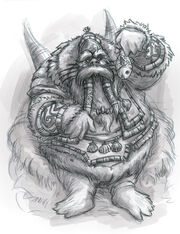
A tuskarr chieftain, perhaps Tusklord Hrak'kar.
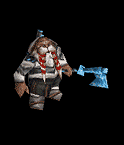
Tuskarr as they appeared in Warcraft III.

Tuskarr in World of Warcraft as seen at BlizzCon.
Tuskarr concept for World of Warcraft: Wrath of the Lich King.
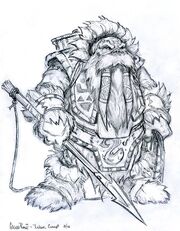
Tuskarr hunter
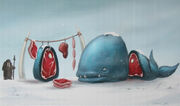
Fishing and whaling are extremely important in Tuskarr society.
The tuskarr are peerless fishermen and whalers. Their self-contained economy is based on the ocean's bounty. These stout-hearted creatures have a budding society along the frozen coasts of Northrend. Although the tuskarr do not yet have an organized society, their villages lay scattered across icy beaches, bustling with activity and commerce. Communities are established to help with fishing, animal husbandry, and defense rather than political interest. The family is the primary social structure, and tuskarr have no community figureheads aside from familial leadership roles. Kinship usually involves three generations from both the mother and father's sides. Functionally, these extended families are treated as one, so the action of a member is the responsibility of the entire group. Marriage occurs as soon as a man can support a wife, and for females as soon as they reach puberty.Template:Cite Template:Cite
Language
Most tuskarr do not learn more than Tuskarr and Common, but those who do speak the tongues of their enemies understand Low Common and Zandali.Template:Cite
Family
The Tuskarr are a simple people who place extreme emphasis on family values. Their hierarchy includes the family first, the larger community second and the individual third. Because of the vulnerability of the Tuskarr, however, the families tend to keep close proximity with the others. When the families must coordinate, a family is picked at random to take charge for that particular situation. Each family has its own implicit leader, but the entire family bears responsibility for each of its members.Template:Cite
Law
Tuskarr laws are simple. No tuskarr may avoid helping tend to the needs of the settlement — gathering food, making clothing and housing, patrolling in defense, etc. The sea is communal property for fishing and whaling. Catches are divided among the community as much as is feasible, with those who miss out on one catch getting first choice the next time. Tuskarr individuals have personal property, but possession is conditioned by actual use.Template:Cite
Tuskarr laws are not meant to punish criminals as much as they are meant to maintain community peace and prosperity. Punishment is mild, usually aimed at injuring one's social position (through gossip, ridicule, or ostracism). Still, some matters are taken seriously. Blood vengeance is always required in return for the taking of a life, which may result in an ongoing feud.Template:Cite
Role of shamans
Tuskarr shamans have the power to influence events such as weather, food, and illnesses. Shaman magic is often quite a production, even something like curing the sick: the shaman may speak with ghosts of the patient's relatives and even battle other spirits into submission before forcing them to help heal the patient.Template:Cite
Hunting
Fishing and whaling form the basis of everything from moral guidance to conversational slang. Boys strive to be good fisherman and girls dream of marrying a good whaler. Success in fishing is a sign of right living, and failure is a sign of moral disorder. The tuskarr afterlife is imagined as a paradise with choice catches and successful whaling without hard work.Template:Cite
To visit a tuskarr village, visitors must bring several fresh fish along, to prove they can fish. Fishing is more than just a means to survive for tuskarr — it’s also a moral guideline. If they think that someone cannot fish well, that is a bad person, so evidence of successful fishing means someone must have good morals and therefore must be respectable. If a person brings several large fish, he is treated like a long lost and much beloved cousin.Template:Cite
Religion
Tuskarr have simple rituals relating to social rather than religious circumstances — birth, marriage, sickness, and death most prominently. Other rituals relate to celebrating a good catch and venerating those who are lost at sea or who fall in battle.Template:Cite
The tuskarr also worship a small pantheon of deities or spirits such as Tayutka, Karkut, and Issliruk.
War
The tuskarr often war with the indigenous ice trolls and nerubian spiderfolk of Northrend. Though they have done well to evade the undead Scourge, the tuskarr know that it is only a matter of time before the legions of the dead come calling. Tuskarr favor spear weapons and nets as their primary tools of war. Tuskarr warriors coordinate in combat, each working to ensure the well-being of the others. Typically, one member of a squad will attempt to snare an enemy in a net, while the others attempt to dispatch the trapped opposition with their spears.Template:Cite
Tuskarr are peaceable people, but they show little mercy to ice trolls, nerubians and anyone else they consider their enemies. While they sometimes organize raids against foes that threaten the ancestral territories where they build their villages, the tuskarr more frequently defend against their enemies. Anyone wreaking havoc on a tuskarr village, however, unleashes the full wrath of these people.
The tuskarr are disciplined and well organized, and each of them takes the defense of his family and village seriously. For many tuskarr, it is a matter of survival, but also of pride, to be prepared against any threat. Because of their reliance on fishing and whaling, tuskarr receive training in the use of nets and spears at a young age. All tuskarr also receive at least rudimentary training in ways to put these implements to use against an intelligent foe. Warriors patrol the areas surrounding their villages and act as lookouts in strategic locations. These warriors warn their people of impending attack.
Tuskarr are determined combatants and they enter warfare much as they do their fishing and whaling efforts, preferring to cast nets upon their enemies and then slay the trapped targets with spears. Tuskarr warriors coordinate their efforts, each working to ensure the well-being of everyone around.
While they follow no particular leader, tuskarr fight in squads composed of 6 to 8 members of the same lineage. The tuskarr abide by the recommendations of the individual with the most warfare experience, or the one they consider the wisest among them if no warriors are in the group. Most often, the leadership of a squad is divided among 2 or 3 members deemed learned in matters of war. Because the members of a squad are family, the tuskarr warriors are not only extremely loyal to one another but also get along together. They are also used to working together — after many years spent fishing and whaling with their brothers — and thus are efficient as a unit in times of war.
The most common tuskarr tactic is to trap an enemy with a net. Typically, one member of a squad attempts to snare a foe while the others dispatch the opposition with their spears. Once an enemy is caught, 2 or 3 members of the squad strike at the trapped foe while the others fight off the opposing forces to protect their fellows.
Sometimes, a squad includes a couple of specialists. The most common specialist is the net thrower, a dexterous fisherman with some experience in warfare whose mastery with the net causes great trouble to opposing troops. Sometimes, a squad also includes one or two javelin throwers. These warriors carry up to a dozen javelins and provide useful cover fire to the members of the squad. Also, when such an individual is available, a squad includes a shaman who can cast spells to hamper the opposition or heal the troops.Template:Cite
Architecture
Tuskarr houses are solidly built structures of wood and stone, with thick, thatched roofs. They are only one story, and sprawl rather than rise, because of the incessant wind. Heavy shutters cover the windows and short entry halls lead from the outer door to an inner one, which keeps heat from escaping and cold from entering. Their homes are radial, with a single large chamber at the middle and the sleeping quarters arrayed around it. They have large pits in the center, lined with stone, and keep a fire blazing constantly — it heats the entire house and has spits and trays for cooking food.
Tuskarr are fishers and whalers, and they use every part of the animals they hunt. Whale bones form support beams in their homes, and heavy sealskins and other furs cover the floors and the doorways. They create dyes from various squid inks and fish scales, and have colorful weavings on their walls.Template:Cite
Clothing
Tusken inner clothing is brightly colored under their thick furs and oilskins. When a tuskarr woman accepts a tuskarr man as her husband, she weaves him a vest and he wears that against his skin. She replaces it once they have children, and again if he becomes the head of their extended family. She repairs it when necessary but otherwise he never takes it off. When males die, they are buried in their most recent vest, and the others are wrapped together to fashion a pillow for the body. Template:Cite
In Wrath of the Lich King
According to new lore from the recently announced Wrath of the Lich King expansion, the tuskarr form an alliance with the culturally similar Horde, and help establish the outpost of Warsong Hold. It should be noted, however, that the tuskarr are a neutral faction, and both the Horde and Alliance will be able to interact with them.[1]
- Shortly upon arriving [in the Borean Tundra of Northrend], the Horde met the tuskarr, a walrus-like race of nomadic fishermen. The two groups have since formed a bond, and the Horde has sworn to aid their new allies in any way possible. [2]
Factions
Locations
- Unu'pe (located in the Borean Tundra)
- Kamagua (Howling Fjord)
- Moa'ki Harbor (Dragonblight)
Description
- Despite the absence of any records documenting the tuskarr's past, many significant facts have recently come to light.
- The tuskarr are a kind-natured nomadic race that roams the southern coastlines of Northrend, guided by the carved cyclopean statues that mark their seasonal fishing routes. The tuskarr's tribal affiliation is evidenced by the sigils inscribed on their tusks, and although they are a peaceful race, they are constantly beset by taunka and local murlocs.
- Yet even their enemies marvel at the tuskarr's prowess and fearlessness in catching some of the most dangerous creatures in Northrend's frigid waters, including whales and giant squid. Not even the unnamed leviathans that lurk in the ocean's depths are beyond the tuskarr's reach.
- The tuskarr have seen their share of difficult times, but with the Horde's recent arrival they have found a new ally in the ongoing struggle against the hostile forces of Northrend.
Note that the line "...although they are a peaceful race, they are constantly beset by taunka and local murlocs." was secretly changed to "...although they are a peaceful race, they are constantly beset by the Kvaldir and an Arctic race of murloc-like creatures known as the Gorloc."
Inspiration

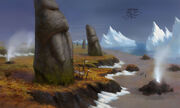
Tuskarr statues in the Borean Tundra
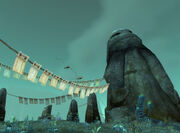
Cyclopean tuskarr statues
This article or section includes speculation, observations or opinions possibly supported by lore or by Blizzard officials. It should not be taken as representing official lore.
|
- While tuskarr appear to be inspired mostly by Inuit stereotypes, concept art also features Moai-like statues, so there might be influences from south-sea island cultures as well, specifically Easter Island (or Rapa Nui).
- The poem of the Walrus and the Carpenter found in Lewis Carroll's Through the Looking Glass.
- Possible outside influence from 1980's cult cartoon Thundercats which featured a species known as Tuska who were humanoid walruses.
- Possible outside reference could be from game "Animal Crossing". In the game, Wendell the Walrus (a humanoid walrus who greatly resembles the tuskarr) who forms his opinion of the player based on the kind of fish the player brings him. Wendell will not give you any paintings, nor will he pay any attention to you, unless you bring him a fish, which is his favorite food. This trait is nearly identical to the tuskarr's judgement of outsiders based upon the fish they present.
References
External links
| ||||||||||||||||||||||||
